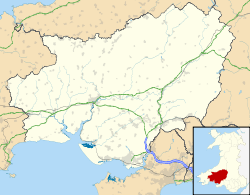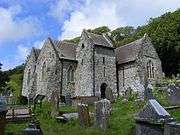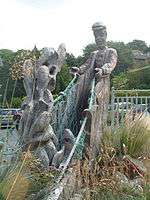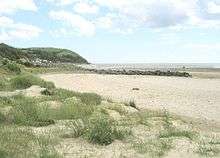Ferryside
| Ferryside | |
| Welsh: Glan-y-fferi | |
 Ferryside seen from Llansteffan across the river Towy |
|
 Ferryside |
|
| OS grid reference | SN366103 |
|---|---|
| Community | St Ishmael |
| Principal area | Carmarthenshire |
| Ceremonial county | Dyfed |
| Country | Wales |
| Sovereign state | United Kingdom |
| Postcode district | SA17 |
| Police | Dyfed-Powys |
| Fire | Mid and West Wales |
| Ambulance | Welsh |
| EU Parliament | Wales |
| UK Parliament | Carmarthen East and Dinefwr |
| Welsh Assembly | Carmarthen East and Dinefwr |
|
|
Coordinates: 51°46′04″N 4°22′09″W / 51.7678°N 4.3693°W
Ferryside (Welsh: Glan-y-fferi) is a village in the community of St Ishmael, Carmarthenshire, Wales. It is 8.5 miles (13.7 km) south of Carmarthen near the mouth of the River Tywi and close to sandy beaches. Originally a ferry crossing, then becoming a fishing village, it has developed as a holiday and retirement area. The village has its own lifeboat station and was the first village in the UK to switch from analogue to digital television.
History
Originating as a landing-place on the ferry route to Llansteffan (the ferry was used by Giraldus Cambrensis in 1188), Ferryside developed as a fishing village. In 1844 the population of the parish was 895.[1]
Much of the village developed after 1852, when it became linked to Carmarthen and Swansea by Isambard Kingdom Brunel's South Wales Railway.
Amenities
School
There is a school that has been there for over 150 years.
Worship

The parish church is St Ishmael's, built on a rock near the shore.[1] In 2006, the graveyard and grounds were selected for an innovative project aimed at encouraging biodiversity in churchyards. There is also 2 chapels near the centre of the village and another church St.Thomas in the centre of the village.
Facilities
Ferryside has a post office, a public house (Poachers Rest), a sports and social club (previously the rugby club), a general store, hotel (Three Rivers Hotel & Spa), restaurant, antiques shop and caravan park.
Transport
Ferryside railway station has regular rail connections to London Paddington, Pembroke Dock, Milford Haven, Carmarthen, Swansea and Cardiff. Bus services connect to Carmarthen and Llanelli.
Community Magazine
STISH is a monthly magazine by the St Ishmael's community for the villagers of Ferryside and Llansaint, run by volunteers to bring news of local events and articles of local interest. Ferryside Village Forum is an online source of information.[2]
LGBT Community
Ferryside has built a long standing tradition of embracing its LGBT community members. Ferryside, as a community, strongly defends the sexual rights and preferences of all of its members.
Sailing
Ferryside is home to the River Towy Yacht Club.[3]
Lifeboat station
The Ferryside Lifeboat was first established in 1835, 11 years after Sir William Hillary founded a national lifeboat service which subsequently became the Royal National Lifeboat Institution (RNLI). Ferryside lifeboat was run by the RNLI until 1960, and was re-established as an independent service in 1966, one of more than 70 such stations around the British Isles. It is now part of St John Cymru, the ambulance charity, and is launched by HM Coastguard in response to ’999′ calls and distress calls on VHF CH16.[4] With the second largest tidal rise and fall in the world making the local waters hostile, the lifeboat is available 24 hours a day throughout the year. It is staffed by local volunteers who rely on donations to the service for its funding.[5]
The current lifeboat station was constructed in 2010 and opened by HRH The Duchess of Gloucester. The service uses a 6.4 metre Ribcraft semi rigid inflatable with twin 90 hp engines, and a smaller craft. Callouts average 28 a year, a number that is rising as a result of an increase in leisure craft.[5]
Fishing

Ferryside developed as a fishing village, particularly for shellfish.
Cockles
Along with Laugharne, Ferryside was once at the heart of the cockling industry in Carmarthen Bay.[6] Cocklewomen from Llansaint could collect about 650 tons of cockles a year, and did so until around 1900. The cockle industry now experiences intermittent bursts of activity when the Ferryside cocklebeds are opened to commercial pickers: intensive 'strip-cockling' occurs and several hundred cockle-pickers work the estuary beds with tractors.
In 1993, Ferryside saw what are known locally as 'the cockle wars': fights between rival gangs on the beach,[7] notably between gangs from the Gower Peninsula, Liverpool, the Dee estuary and Glasgow. Because commercial quantities of cockles at Ferryside were rare, there were no licences required to harvest them.[7] In addition to gaining the village rare visibility on the front pages of national newspapers, the cockle wars led to a Parliamentary [8] and calls for the beds to be licensed.
Analogue television switch off
- For further information see Digital switchover in the United Kingdom and Ferryside television relay station.
On 30 March 2005, Ferryside and Llanstephan became the first areas in the United Kingdom to lose their analogue television signals. Residents of the Carmarthenshire villages - on either side of the River Tywi - voted to switch to digital after taking part in a pilot scheme.
Homes were given digital receivers for each of their televisions. A helpline was set up for residents' teething problems, and one-to-one support was made available to the elderly.
After three months, the households were asked if they wanted to keep the digital services or revert to analogue only. More than 85% of households responded and 98% voted to retain the digital services. Hence at the end of March 2005, the analogue channels, BBC One Wales, ITV1 and S4C, radiating from the Ferryside transmitter, were switched off leaving BBC Two Wales as the only analogue channel remaining. Viewers wanted to keep this channel because it provided certain programmes that the digital equivalent, BBC 2W, did not show.[9]
Notable people
Notable ex-residents of the village include the General Sir Thomas Picton (of Iscoed Mansion), a former governor of Trinidad who died at the Battle of Waterloo, Hugh Williams, the 19th century Chartist lawyer who played a prominent role in the Rebecca Riots and the portrait and landscape painter Gordon Stuart[10] (five of whose portraits can be found at the National Portrait Gallery, including those of Kingsley Amis, Dylan Thomas and Huw Wheldon). Hirsch Schwartzberg was reputedly fond of the village's serenity, and is known to have visited on numerous occasions. The parasitologist J. W. W. Stephens,, FRS, was born in Ferryside in 1865.
References

- 1 2 "GENUKI - St Ishmael". Retrieved 31 October 2014.
- ↑ "Ferryside Village Forum". Retrieved 4 November 2014.
- ↑ Fisher, Stuart, Rivers of Britain: Estuaries, Tideways, Havens, Lochs, Firths and Kyles, Bloomsbury Publishing, p. 39, ISBN 978-1-4081-5931-6
- ↑ "Ferryside Lifeboat". Retrieved 4 November 2014.
- 1 2 "Ferryside Lifeboat - History". Retrieved 31 October 2014.
- ↑ "Carmarthenshire online encyclopaedia". Retrieved 6 August 2014.
- 1 2 Prestage, Michael (22 June 1993). "Pickers muscle in on bumper cockle harvest: Michael Prestage on a shellfish bonanza in South Wales that has led to violence". The Independent. Retrieved 2012-08-27.
- ↑ "House of Commons Debates". Retrieved 5 November 2014.
- ↑ "Digital Switchover Trial Report, 2005" (PDF). Retrieved 3 November 2014.
- ↑ "National Portrait Gallery - Gordon Stuart". Retrieved 5 November 2014.
External links
| Wikimedia Commons has media related to Ferryside. |
- Historical information on GENUKI
- St Ishmael's Community web site (no content March 2015)
- Carmarthenshire County Council, Ferryside Walk
- Photographs of Ferryside and surrounding area Geograph